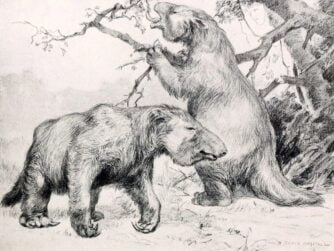Voice 1
Welcome to Spotlight. I’m Bruce Gulland.
Voice 2
And I’m Megan Nollet. Spotlight uses a special English method of broadcasting. It is easier for people to understand, no matter where in the world they live.
Click here to follow along with this program on YouTube
Voice 1
A small woman stands on the edge of a beach. It is on a coast in United Kingdom. The air smells of salt and mud. And the beach is full of rocks and small pools of water. The woman wades through these pools. She is looking for a small, red plant called laver. It is a kind of seaweed. Seaweed like laver grows in many countries. One species is very important in Japan. There people make food out of it. They call it nori. But the seaweed is mysterious. No one knows how it grows!
Voice 2
This woman’s name is Kathleen Drew-Baker. She has made it her goal to understand this kind of seaweed. She is not being paid for studying seaweed. She is doing it because she is interested. Most people would not care about her work. But by studying seaweed, Kathleen Drew-Baker will save a whole industry.
Today’s Spotlight is on Kathleen Drew-Baker.
Voice 1
Kathleen Drew-Baker was a scientist and researcher from the United Kingdom. She was born in 1901. She became a scientist when she was very young. And she was one of the first women to teach at her university. But Drew-Baker’s life in science was not easy. Although she was smart, it was hard for her to lead in a science field. Susan Hand Shetterly is a science writer. She wrote about Drew-Baker in her book “The Seaweed Chronicles.”
Voice 3
“She lived in a time when women in science were not taken seriously if they chose to marry. When she married, she was let go from her job. In time she returned to the university as a research assistant. But, in the years between, she worked out of her own laboratory. Her husband, also a scientist, built her the laboratory at their home.”
Voice 2
Drew-Baker’s university believed that she would only be a mother and wife. But she continued her studies, even after having two children.
Voice 1
Drew-Baker achieved many things in her life. But most people know her for her work with nori. Nori is a very important crop in Japan. The Japanese people have used it in food for over a thousand years. They use it to flavor dishes. They create a paper from it to make sushi and rice balls.
Voice 2
But for a long time, no one knew where nori came from. Nori did not have seeds, like some plants. Instead, farmers created nets that they would put in the water. The nori would grow on the nets. In some years, the harvest was good. In otheryears, the harvest was bad. There was no way to control how much nori farmers would get.
Voice 1
Then, in the 1940’s, there was a very bad harvest. Many more bad harvests followed. Several typhoons, a kind of strong storm, hit Japan. It killed a lot of the nori. Pollution killed even more. Soon, there was almost no nori at all. It had disappeared.
Voice 2
Kathleen Drew-Baker did not know this when she started studying seaweed. She had never been to Japan. She did not even know the word nori. She called it the seaweed laver.
Voice 1
Drew-Baker was very interested in laver. She noticed that it only seemed to grow during winter. It sent out spores in order to grow more. But nothing would grow for a whole year. Where did the spores go? And why could no one grow laver?
Voice 2
Often Drew-Baker experimented with the seaweed. She gathered the plants from the shore. Then she planted them in a big tank. She tried to discover what made them grow. But she could never do it. She worked with laver for almost nine years!
Voice 1
One day, Drew-Baker had an idea. She threw some shells into the tank. The seaweed behaved as it normally did. But soon, she saw something grow on the shells. It was a red slime. Drew-Baker was disappointed. She believed that this was a different kind of plant growing. She feared that her experiment was ruined.
Voice 2
But she soon learned that she was wrong. The red slime was laver. It was just a different part its life stage. During the summer, the laver grew as the red slime on shells. It needed them to grow. They also protected the plant from heat and rough seas. During the winter, laver would leave the shells. It would grow high up so that it could reach the sun. Drew-Baker had finally discovered laver’s secrets!
Voice 1
This discovery was very important to Drew-Baker. But it was even more important than she knew at first. Sokichi Segawa was a Japanese biologist. He studied underwater plant life. And he was worried about nori disappearing. Then he heard about Drew-Baker’s discovery. He knew that nori was very similar to laver. Maybe it would grow in the same way, too? He filled a tank with nori and shells. Soon, the same red slime began to grow. Then, the seaweed followed.
Voice 2
Segawa finally understood what had happened to the nori. The strong storms had disturbed shells that the nori grew on. Pollution made it hard for them to grow back. It was not just the nori that had disappeared. It was the shellfish too.
Voice 1
Soon others began to grow nori in tanks. And they took better care of shellfish in growing areas. It took a long time. But the nori crop began to recover. Farmers could control how much they grew. So, more and more people could eat nori.
Voice 2
Today, the nori industry is very large. People eat it all over the world. And the people who grow it still use Kathleen Drew-Baker’s methods.
Voice 1
But Drew-Baker did not live to see her work’s success. She made her discovery in 1949. And she died in 1957. Her life was not an easy one. People did not accept her. They dismissed her because she was a married woman. But she continued doing what she loved. And because of it, Kathleen Drew-Baker saved an industry.
Voice 2
Today, nori farmers honor Drew-Baker’s memory. In 1963, they made a statue for her in Uto City, Japan. And, every April fourteenth, there is a celebration in her name. It is called the Mother of the Sea Festival.
Voice 1
Dr. John Rendle is one of Drew-Baker’s children. He visited Japan. And he spoke at the festival honoring his mother.
Voice 4
“My mother never knew what an important change her work would bring about. She studied seaweed just to know more about it. But, without her work, the wholeindustry would be gone. I do not know what my mother would think about it now. She would be surprised. What she did back then turned into a multibillion-dollar industry. But I do not think she would like sushi. She was not very adventurous when it came to food.”
Voice 2
Kathleen Drew-Baker saw creation as an ordered place for careful study. Confidence in her work allowed her to discover the secret of laver’s growth. Her discovery allowed Japan to recover seaweed farming and benefit the world of sushi.
Voice 1
Have you ever eaten sushi? Do you enjoy the flavor of sushi? We want to hear your thoughts! You can leave a comment on our website at www.spotlightenglish.com. You can also find us on YouTube, Facebook, Instagram, and Twitter.
Voice 2
The writer of this program was Dan Christmann. The producer was Michio Ozaki. The voices you heard were from the United Kingdom and the United States. All quotes were adapted for this program and voiced by Spotlight. This program is called, ‘The Woman Who Saved Sushi’.
Voice 1
Visit our website to download our free official app for Android and Apple devices. We hope you can join us again for the next Spotlight program. Goodbye.
Question:
Have you eaten sushi? Do you enjoy the flavor of sushi?








I only had sushi once. I find it normal that everyone loves the food, customs and traditions of the country where they were born. I would give the gold medal to three autumn foods: chestnuts cooked over a flame in a pan with holes, which are called “roasted chestnuts”. Then the “peppers” and finally the sweet potatoes which are called “American potatoes”.
I’ve had sushi once and I didn’t like it. But that’s because I don’t like seafood at all. However, we have to admit that sushi is very popular in Japan and is part of traditional Japanese cuisine.
I haven’t eaten sushi befor, and I don’t think I’d like or enjoy the flavor cuz I don’t like raw fish and see weeds.
No, I haven’t
I would like to taste it but, I’m apprehensive to eat it
I don’t like …
I don’t eat sushi before totally , however I seen many times in the dinner before in many parties in Dubai
I don’t eat sushi before totally , however I seen many times in the dinner before in many parties in Dubai.
No I didn’t I wish eating sushi in future
This women is strong !! I LOVE soche he is bueteful
No, I have not eaten sushi before, but I would like to try it soon. I have not eaten it, so I do not know. You have to ask someone who has eaten it. For example, ask my friend Heba Elsharawi, and she will tell you.
I love sushi and now I am grateful with Kathleen Drew-Baker
goooood
yes, its so delicious.
This is very important information about food from
No I didn’t eat it before but I hope to experience it
No, I haven’t tried sushi before but I would like to try it someday.
a sushi delicious dish but that depend on it preper’s way and it ingredients , it in not popular dish and not the maine dish , also it had a high price , I eaten it .
No I haven’t
and I will try to eat sushi in future Bec I like to know what the taste is
no, i haven’t sushi, because i didn’t usually eat it.
When I was teenager, I love enjoying sushi. Their ingredients creation is grate. Whenever I go out to eat, I buy sushi from a restaurant which has sushi. But, with I getting older, I had a problem with sushi. After I eat it, I can’t go to the bathroom for 3 or 4 days. And I don’t feeling well. Rice from the inside it make me this problem. So love eating all the snacks that make it from seaweed except sushi.